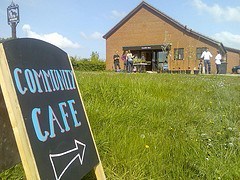Representation 1: Unstructured Meeting Space
In my last post, I described my three functions model. The next step is to explore the three functions. Here they are:
- Representation
- Planning
- Delivery
You need to do three things (covered in this and the next two posts) to develop representation in a neighbourhood.
- Provide an unstructured meeting space
- Generate and record deep conversations
- Agree a community plan
For over 10 years the area where I live had a Forum. It was called Burngreave Community Action Forum or BCAF. It met once a quarter on a Saturday mornings and at least 60 people turned up.
This approach has financial costs if you’re going to do it properly. You need to pay for a leaflet through every door, backed up by posters and announcements in local papers, etc. A free lunch also helps, it is an opportunity to socialise and maybe some people turn up for the lunch who wouldn’t otherwise. BCAF also provided childcare and a translation service.
Any neighbourhood wishing to develop community needs a meeting place. Quarterly meetings are one possibility. Another might be a community centre with a café.
Think in terms of “unstructured meeting spaces”, where people can meet without an agenda. Some community centres offer rooms for hire but no space where people can grow community. Even more worrying are neighbourhoods with no meeting spaces at all.
Roles for Unstructured Meeting Spaces
So, what might you aim for? It’s likely your centre will need to pay its way and so I’ve included some suggestions for paid activities.
- A space for people to call in and hang around.
- A coffee bar, offering snacks and drinks.
- Toilets are essential in any neighbourhood and get people through the doors.
- Child care activities
- Noticeboard and / or a TV screen for local events.
- Information can be placed on tables or in racks.
- If the centre is well used, small businesses or charities might pay to have an occasional stall (or you might donate a slot to charities).
- Exhibitions are a good way to draw people in and some can be commercial to bring income into a centre.
- Local artists could display their work for sale, perhaps paying for the period they’re on view or a proportion of sales.
- Rooms for hire in the building can help generate income in various ways. Meetings will draw people into the building and they may need refreshments. Public meetings might ask people in the café if they are interested in joining them.
- Entertainment should be publicised in advance whether it is free so that customers know what to expect
- If a church runs this service they might consider a quiet space (any centre could do this) or prayer or meditation groups.
So far, I’m describing how a neighbourhood might bring residents together. But how do you generate and record deep conversations in a coffee bar or indeed any meeting? Let me know what you think and I’ll offer my suggestions in my next post.
